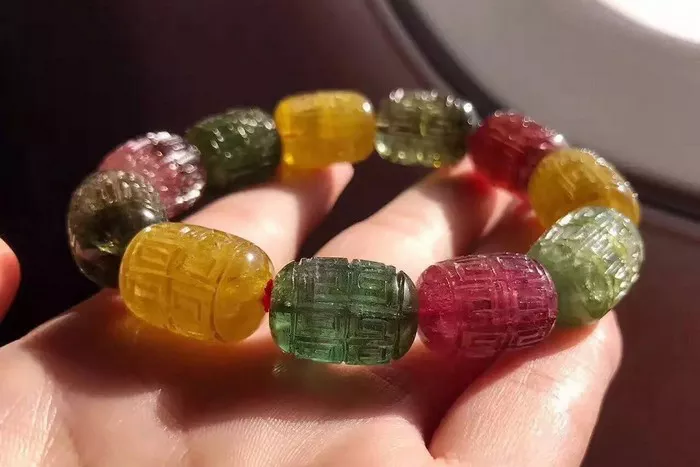Tourmaline, known scientifically as tourmaline, is a gemstone belonging to the borosilicate crystal family. It contains various chemical elements such as aluminum, iron, magnesium, sodium, lithium, and potassium. The name “tourmaline” is derived from the ancient Sinhalese word “Turmali,” meaning “mixed gemstones.” This reflects its complexity and versatility in color and composition.
In the international jewelry industry, tourmaline is primarily classified based on its color, and the richer the color, the higher its value. When purchasing tourmaline, consumers should pay attention to its color, transparency, and purity. Tourmaline is also often referred to as the “wish stone” due to its weak energy-absorbing properties. In some cultures, it is believed to bring good luck and avoid evil.
Characteristics of Pink Tourmaline
Pink tourmaline, as a variety of tourmaline, possesses unique characteristics that distinguish it from other gemstones. Here is a detailed introduction to pink tourmaline:
Color and Appearance
Pink tourmaline exhibits a delicate and soft pink hue, which is reminiscent of the warm glow of dawn or the blush of a sunset. This color is highly appealing to many people, especially those who appreciate soft and romantic tones. The crystal structure of pink tourmaline is complex, often displaying parallel stripes along the extension direction of the columnar crystal. In cross-section, it presents a curved spherical triangle shape.
Energy and Healing Properties
From a metaphysical perspective, pink tourmaline is believed to carry specific healing properties. It is associated with the heart chakra, which is the center of love, compassion, and emotional well-being. Pink tourmaline encourages individuals to let go of negative emotions, relax, forgive, and make space for love. It helps to clear blockages in the heart chakra, allowing new energy and optimism to flow in.
By working with pink tourmaline, people can develop a deeper connection with their inner selves, learn to trust life, and stay true to their inner guidance rather than seeking validation from others. This gemstone also fosters feelings of gratitude, respect, and love, promoting openness and trust in life.
Physical Properties
Pink tourmaline is a relatively hard gemstone, with a hardness ranging from 7 to 7.5 on the Mohs scale. This makes it suitable for use in jewelry that will be worn frequently and exposed to wear and tear. Despite its hardness, pink tourmaline should still be handled with care to avoid scratches or damage.
The transparency of pink tourmaline can vary, from translucent to opaque. Some varieties may exhibit a phenomenon called dichroism, where the gemstone appears to change color depending on the angle of viewing. This unique property adds to the allure of pink tourmaline and makes it a sought-after gemstone for collectors and jewelers.
Sources and Varieties
Pink tourmaline is found in various locations around the world, including Brazil, Madagascar, Africa, and the United States. Each source produces tourmaline with slightly different characteristics, such as color saturation, clarity, and cut.
Within the category of pink tourmaline, there are several varieties, each with its own unique appearance and properties. Some of these varieties include watermelon tourmaline, which has a pink center surrounded by green outer layers, and rubellite tourmaline, which exhibits a more intense pink or red hue.
Characteristics of Blue Tourmaline
Blue tourmaline is another popular variety of tourmaline that offers a striking contrast to pink tourmaline. Here is a detailed introduction to blue tourmaline:
Color and Appearance
Blue tourmaline ranges in color from light sky blue to deep indigo, offering a wide range of options for jewelry designers and collectors. The color of blue tourmaline is often influenced by the presence of trace elements such as iron and titanium within the crystal structure.
The appearance of blue tourmaline can vary greatly depending on its clarity, cut, and source. Some varieties may exhibit a phenomenon called asterism, where tiny inclusions within the crystal create a star-like pattern when viewed under certain lighting conditions.
Energy and Healing Properties
Blue tourmaline is believed to carry calming and soothing properties, making it an excellent choice for individuals seeking relief from stress, anxiety, and tension. It is associated with the throat and heart chakras, which are responsible for communication, self-expression, and emotional balance.
By working with blue tourmaline, people can develop a stronger connection with their inner selves, learn to communicate more effectively, and express their thoughts and feelings with clarity and confidence. This gemstone also encourages self-reflection and inner peace, promoting a sense of harmony and balance within the individual.
Physical Properties
Blue tourmaline shares similar physical properties with pink tourmaline, including a hardness of 7 to 7.5 on the Mohs scale and varying degrees of transparency. Like pink tourmaline, blue tourmaline may also exhibit dichroism, adding to its visual appeal and making it a unique gemstone for jewelry creation.
Sources and Varieties
Blue tourmaline is found in several locations worldwide, including Brazil, Madagascar, and Sri Lanka. Each source produces tourmaline with distinct characteristics, such as color saturation, clarity, and cut.
Within the category of blue tourmaline, there are several varieties, each with its own unique appearance and properties. Some of these varieties include indicolite tourmaline, which exhibits a deep blue hue, and paraiba tourmaline, which has a vivid, neon-like blue color that is highly sought after by collectors.
Conclusion
In conclusion, pink and blue tourmaline are two popular varieties of tourmaline that offer a wide range of options for jewelry designers and collectors. Both gemstones possess unique characteristics that distinguish them from other gemstones, including their delicate colors, healing properties, physical properties, and sources.When choosing pink or blue tourmaline for jewelry, it is important to consider the individual’s preferences, style, and budget. Whether you are looking for a delicate pink tourmaline pendant or a striking blue tourmaline ring, these gemstones offer a timeless beauty that will be treasured for generations.
Related topic:
- Is Tourmaline Found in China?
- Amethyst and Black Tourmaline: Can You Wear Them Together?
- Pink Tourmaline or Rose Quartz: Which is Better for Everyday Wear?


